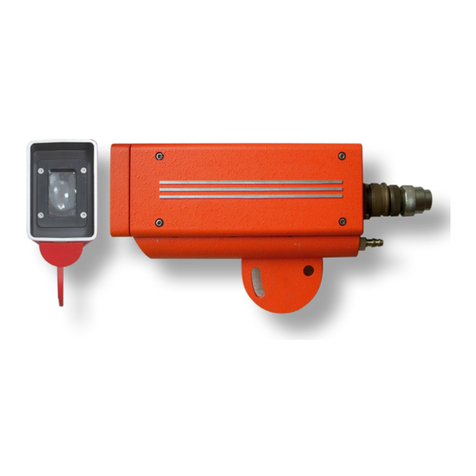
Installation, use and maintenance manual
31
4 REPLACING
ID2000
AND
ID2200
MODELS
The ID2202 is designed to replace, with improved features, the following models:
ID2000: HMD for high temperatures
ID2200: HMD for low temperatures
Improved features are:
SSEL input to select the sensitivity, depending on its setting, thus allowing to use the ID2202 both
as ID2000 and ID2200. So it is possible to use just one HMD’s model in several parts of the plant,
where the rolled product temperature is different.
The SSEL input allows using the ID2202 in plant areas where the rolled product temperature is
high or low depending on the product, for instance at the exit of a water box that can be switched
On or Off. To set the most appropriate sensitivity is sufficient that automation controls adequately
the SSEL input.
The ID2202 horizontal visual angle is narrower and more accurate as to ID2000 and ID2200, so
that accuracy of detection is improved.
If the ID2202 is used to replace ID2000 (SSEL=1), its insensitivity to sunlight is 100 times more
than ID2000’s.
Two-toned rear LED which signals when the IR signal received is near the presence of material
threshold, and therefore the detection is uncertain
Digital output to signal proximity to the presence of material threshold, and other malfunctions.
Front LED of presence of material (in addition to the rear one) so as to make easier the sighting
check.
4.1 I
NPUT AND OUTPUT COMPATIBILITY
the ID2202 is electrically compatible with ID2000 and ID2200 models, with the following exceptions:
the ID2202, differently from ID2000 and ID2200, does not have the NPN output of presence of
material (pin B). On this pin ID2202 has the HEALTHY output, PNP type
To enable the test function, it is necessary that ID2000 and ID2200 apply a 24V between the pins F
and E. In ID2202, instead, the test function is enabled by applying 24V just on pin F, whilst pin E is
used as input for selecting the SSEL sensitivity.
Example ID2200, wired as follows:
only the PNP output of presence of material is used (the most common case)
the TEST function is enabled by applying 24V to pin F and 0V to pin E.
In this case it is possible to replace ID2200 with ID2202, without any wiring change. Since the pin E is
connected to 0V, ID2202 shall have a high sensitivity setting, that is a sensitivity similar to ID2200.
Thus, change of wiring is avoided, but obviously the additional functions of ID2202 (SSEL output and
HEALTHY) are lost. If HMD is installed at the exit of a water box which may be off or on (therefore
HMD should detect a hot or cold material), it may be advisable cabling at least the SSEL input to a PLC
so as to dynamically set sensitivity.
Example ID2000, wired as follows:
only the PNP output of presence of material is used (the most common case)
the TEST function is enabled by applying 24V to pin F and 0V to pin E.
In this case ID2000 can be replaced by ID2202, but it is necessary to change cabling so as to connect
the pin E (SSEL) to 24V, and then to set low sensitivity (similar to ID2000).
As an alternative the original wiring can be kept and the adjusting potentiometer be turned to the
minimum. The resulting sensitivity shall be similar to that of ID2000.
Danieli Automation Standard - Installation Use and Maintenance Manual - ID2202
Certified by OneDoc A.620.107 Rev.04-MU 32/145 #1061394




























